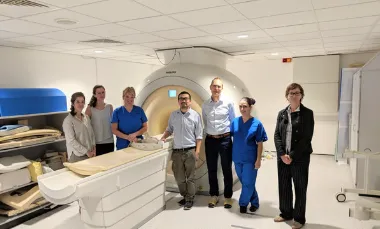We want to see if a sophisticated scanning technique which measures the levels of these two particular neurotransmitters in the brain could allow earlier prediction of neurodevelopmental conditions in newborn babies known to be at risk.
Dr Tomoki Arichi, Lead Researcher at the School of Biomedical Engineering & Imaging Sciences
26 September 2018
Baby brain scans that could help predict symptoms of autism and ADHD: new study announced
London researchers are set to start a three year study aiming to identify babies at higher than average risk of autism spectrum conditions and attention deficit hyperactivity disorder.

London researchers are set to start a three year study aiming to identify babies at higher than average risk of autism spectrum conditions (ASC) and attention deficit hyperactivity disorder (ADHD).
The work at King’s College London is set to commence on 1 October with funding of £199,968 from children’s charity Action Medical Research.
Understanding altered brain developement
Both ASC and ADHD are common in childhood, as lead researcher Dr Tomoki Arichi (School of Biomedical Engineering & Imgaging Sciences) says, 'ASC is estimated to affect one per cent of children in the UK (1, 2) and typically leads to impaired social interaction and communication. ADHD is more common, affecting up to five per cent of UK children (1, 2) and is characterised by overactivity, impulsive behaviour and difficulties in paying attention.'
It is already known that a family history of ASC or ADHD puts a child at a higher risk of developing these conditions. However it is still not known exactly what makes a baby vulnerable to later have these conditions. This has made it difficult to identify, develop and deliver interventions to those who need it most.
There is now evidence that understanding the balance between two chemical messengers in the brain – known as neurotransmitters – called glutamate and GABA, may be key to unpicking what leads to altered brain development.
The researchers hope that earlier information to help predict which children may go on to have difficulties with these conditions will open the door for support to be provided from infancy to those most in need, greatly helping children and their families.
Dr Arichi and his colleagues, physicist Dr Enrico De Vita (School of Biomedical Engineering & Imaging Sciences) and psychiatrist Dr Grainne McAlonan (Institute of Psychiatry, Psychology & Neuroscience), are exploring the role of these two brain chemicals in shaping the developing brain.
A study with state-of-the-art scanners
The team will use Magnetic Resonance Imaging (MRI) scanners and a state-of-the-art method called magnetic resonance spectroscopy (MRS) which can measure the levels of chemicals in the living brain safely and precisely.
They will measure glutamate and GABA levels in the brains of 80 newborn babies using a MRI scanner at St Thomas’ Hospital London with special adaptations and staff for scanning babies. They will also pioneer scanning babies on a new, highly powerful 7 Tesla MRI scanner which is being installed at St Thomas’ Hospital.
Half the babies will be at high risk of developing a neurodevelopmental condition, due to an affected close family member, and half will have no increased risk – this group will be our control.
Dr Tomoki Arichi, Lead Researcher at the School of Biomedical Engineering & Imaging Sciences
The researchers will compare results between the two groups to see if there are any differences.
Dr Tracy Swinfield, Director of Research at Action Medical Research, comments: “Action Medical Research is very pleased to support this study. This research could lead to a new, safe, non-invasive technique to identify babies who may develop difficulties later in childhood, enabling early support and intervention where appropriate.”
“Studying neurotransmitter levels in the brain in early life could also help to inform new treatment strategies for currently incurable conditions such as ASC,” adds Dr Swinfield.
References:
- National Institute for Health and Care Excellence, Clinical Knowledge Summaries: Autism in Children
- Sayal, K., et al, ADHD in children and young people: prevalence, care pathways, and service provision. Lancet Psychiatry. 2018; 5(2): 175-186.
